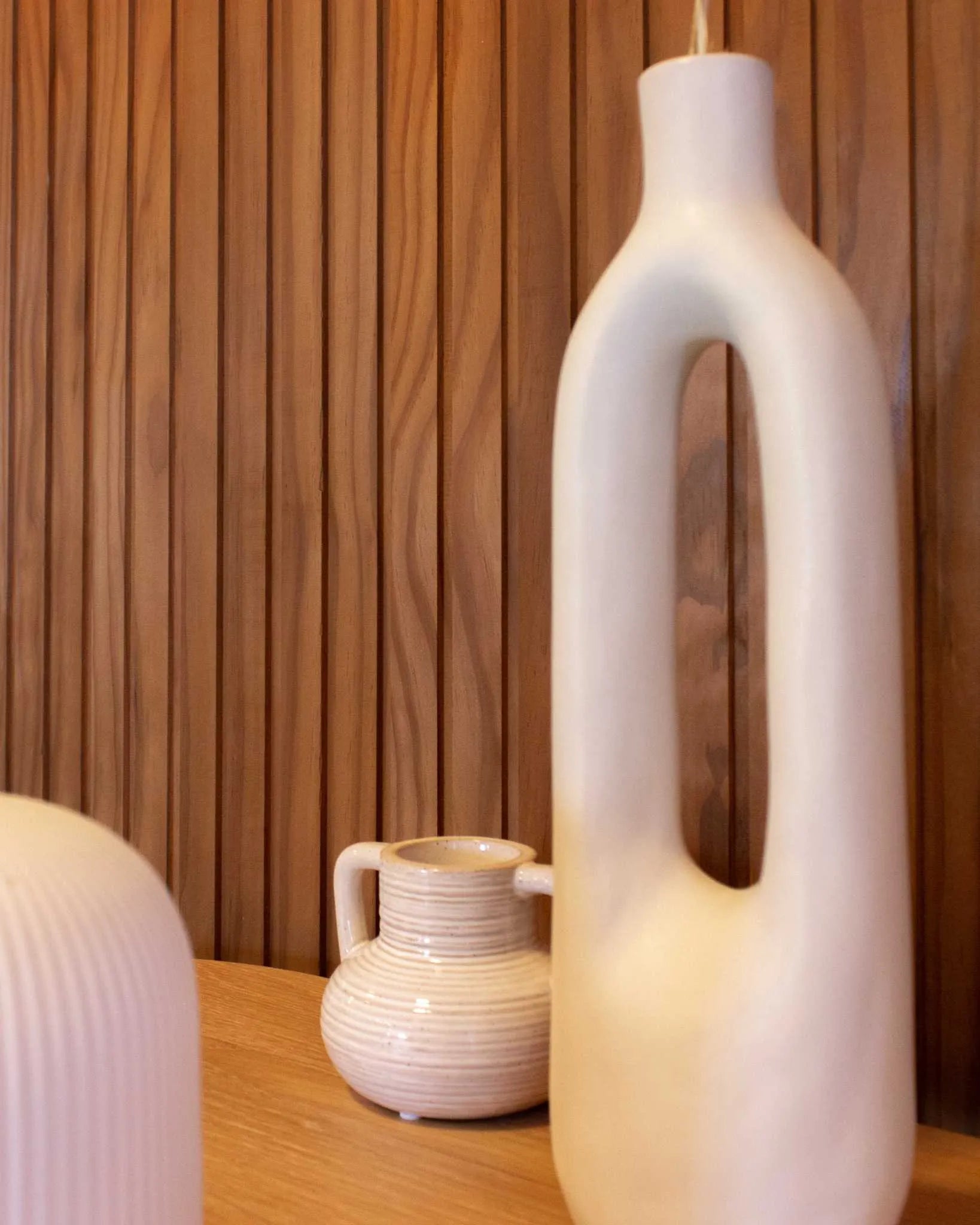In 2023, decorating is done more responsibly, with softness, coziness, and naturalness visible in the decor.
The cycle of new interior design trends has slowed, extending the duration of trends already in place. Nature-inspired decor that cherishes wood and other natural materials remains popular in 2023. The trend-conscious decorator aims for long-lasting and high-quality choices.
All-white, angular decor has receded, and now warmth and coziness are desired in the home. Popular are various shades of beige and brown as well as strong colors like purple, magenta, burgundy, and muted yellow. Dark wood, especially pine, is now allowed to shine, and the decor takes on the spirit of warm 70s.

In 2023, a warm dark panel is chosen for the ceiling. Product: Lämpödyyni
Nature and naturalness
Calming, wellness-supporting natural decor continues to be popular. The soothing effect of nature is brought into the home through materials and shades. Natural materials such as wood, stone, and linen are chosen for the home. Natural light floods in through large windows.

The living-surfaced Dyyni panel made from domestic pine brings nature into your home.
In wood materials, the naturalness of wood should be visible. The surface treatment is chosen to preserve a natural finish, heat treatment, or dark brown. Among wood species, especially domestic pine is the choice of the trend-conscious interior designer. Wood is visible in ceilings, feature walls, and furniture. Various slats and slat walls also continue to be popular.
Add a natural feel to the interior with textiles and real green plants. Green plants can be abundant both on walls and as arrangements on tables.

A natural slat wall is created from domestic pine slats.
Harmony and decorative moldings
Nature is also visible in the trend that has been on the rise for a while In Japandi interior style. Timeless Japandi combines Japanese and Scandinavian design language, emphasizing harmony and tranquility.
Japandi style favors natural materials such as wood. Typically for Japanese style, dark wood and dark shades are used boldly. At its best, Japandi is a harmony of light and dark shades, creating controlled contrast between them.
In the Japandi style direction, less is more, and choices are made thoughtfully. Furniture is restrained, and the interior is kept minimalist. The color scheme is overall very calm and inspired by nature. The goal of this style is to create spaces that promote well-being, calmness, and harmony.

In Japandi interior style, light and dark shades create a harmonious whole. On the wall, white lacquered Dyyni panel.
Alongside the Japandi style direction, there is also Classic style direction. The luxurious Classic style is characterized by grandeur, harmony, and layering.
In classic interior design, wood is an important element. The style favors delicate wall panels and striking decorative moldings.
Create the style in your home by building a magnificent and striking wall with Deco decorative moldings. Don't be afraid of contrast; boldly combine dark wood or other dark details with light surface materials. Complete the style with large rugs and furniture, marble, and glossy details. Don't be afraid of contrast; boldly combine dark wood or other dark details with light surface materials.

The magnificent Classic style is created with striking decorative moldings.
Warmth and retro spirit
Scandinavian all-white interiors are starting to fade into the background as warmth and colors take over home spaces. The 2023 interior design draws inspiration from 70s retro homes.

Harmony of brown shades. The ceiling of this bathroom features thermally treated radiata pine paneling, and texture is added to the space with a ready-to-use Dyyni panel wall, tinted to match the ceiling panel.
A trend-conscious decorator picks muted green, yellow, and brown shades familiar from the 70s for their color palette. Textiles feature velvet and leather, and a beautiful rya rug is chosen to decorate the wall.
Dark wood is seen as accent walls, ceiling panels, and slatted walls. The wood is now treated in dark brown shades, allowing its grain to shine. The natural shade of domestic pine is allowed to yellow naturally, or it is treated with dark brown tones.

In a bathroom exuding modern retro vibes, beautiful brown thermowood paneling has been used alongside green tiles, as well as Dyyni paneling tinted to the same shade.
Decorate with wood in 70s style:
Finger-jointed panel. This classic panel has made a comeback in Finnish homes over the past couple of years, and its popularity continues. The finger-jointed panel, representing soft shapes, enlivens the space and has numerous different uses. Nowadays, it is available with many different surface treatments and made from various raw materials. Get inspired by the different uses of the finger-jointed panel.
Slatted wall. Add depth to your interior with a slatted wall. A slatted wall can be a stunning focal point in a space or serve as a convenient room divider. Slats can also create privacy or hide, for example, radiators behind beautiful slatting. Various planed products are suitable for slats. A slatted wall or ceiling can also be easily created with slat panels.
Thermowood. These beautiful brown products are high-quality interior and exterior cladding panels suitable for all spaces and conditions. Thermal treatment improves the wood's resistance to rot, weather resistance, and thermal insulation properties, as well as reduces moisture movement. Thermowood products have a very beautiful natural brown shade.

Play boldly with slat paneling. Beautiful brown slat paneling is made from thermal wood.
Round and soft shapes
One of this year's biggest trends is the round and curved design language. Round design language is now everywhere—in furniture, lighting, textiles, and shapes on walls. Curved shapes can be found in mirrors, windows, and doorways.
The round design language is also visible in wooden interiors, for example in moldings and panels. Finger panels decorate homes on feature walls, ceilings, headboards, and furniture. Try covering cabinet doors with finger panels or refurbish an old coffee table with finger panels.

An old coffee table adapts to modern times with finger paneling.
Play with fun half-round moldings! You can use half-round moldings on window and door frames, on walls like slats, or cover, for example, the kitchen island with them.

Half-round moldings play on the walls and kitchen island.
Ode to colors and textures
Although this year's trends strongly feature earthy brown and beige tones, now it's also allowed to go wild! The use of colors in interior design is intensifying even more. Interiors will overall showcase more colorful implementations, playfulness, and bold color combinations. Pastel shades interestingly combine with dark, deep color worlds, and interiors will feature colorful and playful details.

This year is a celebration of colors. Dyyni panel also adapts beautifully to green.

Surface materials feature shades of brown, yellow, and amber. Brown-treated finger-jointed panel doors bring warmth to the hallway.
Alongside colors, many lively materials and patterns inspired by nature are seen. Boldly combine different textures and create interesting contrasts with them. The natural surface should be visible, and for example, the wood's own natural patterns or knots are not hidden.

A calming atmosphere is created by lively wood surfaces combined with a beautiful terracotta shade. On the wall white-lacquered Dyyni panel.

Pine slats painted the same shade as the wall mäntyrimat add interesting texture to the space.
Ecology and responsibility
One of the biggest megatrends of our time is ecology and recycling. At the same time, the variability of interior trends has diminished, and prevailing trends last longer. Interior purchases focus on quality and durability, as well as renewable raw materials.
The trend-conscious interior designer acquires furniture second-hand or renovates old pieces. The home is decorated with recycled furniture, and old furniture gets a new life through renovation or upcycling.

The trend-conscious interior designer acquires furniture second-hand. The wall's half-paneling uses brown-toned Dyyni paneling.
Material choices aim to select durable and high-quality, renewable raw materials. Finnish wood is an ecological material option. Wood is a biodegradable and renewable natural material that returns to the cycle at the end of its life cycle. Wood products are timeless and durable, and they are easy to modify and vary over time. Wood is also easy to repair or reuse.
Tips for the trend-conscious interior designer:
- Let nature show in your interior by choosing natural materials
- Create harmony by combining light shades with dark wood
- Get inspired by classic decorative moldings
- Bring a touch of retro spirit to your interior with slatted walls and warm wood products
- Play with round and curved shapes: try finger-jointed panels or fun half-round moldings!
- Boldly combine different textures and colors
- Aim for quality and durability in your interior choices



